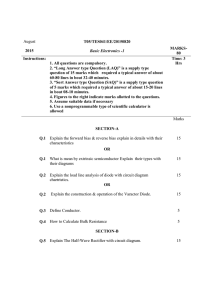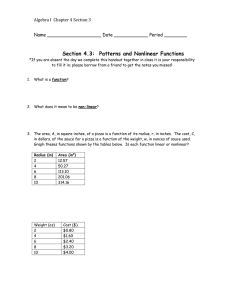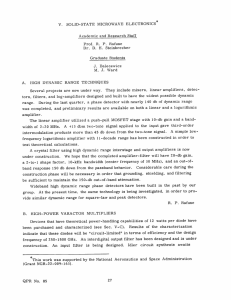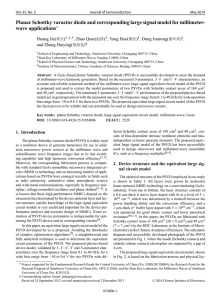XVII. CIRCUIT THEORY Prof. S. J. Mason
advertisement
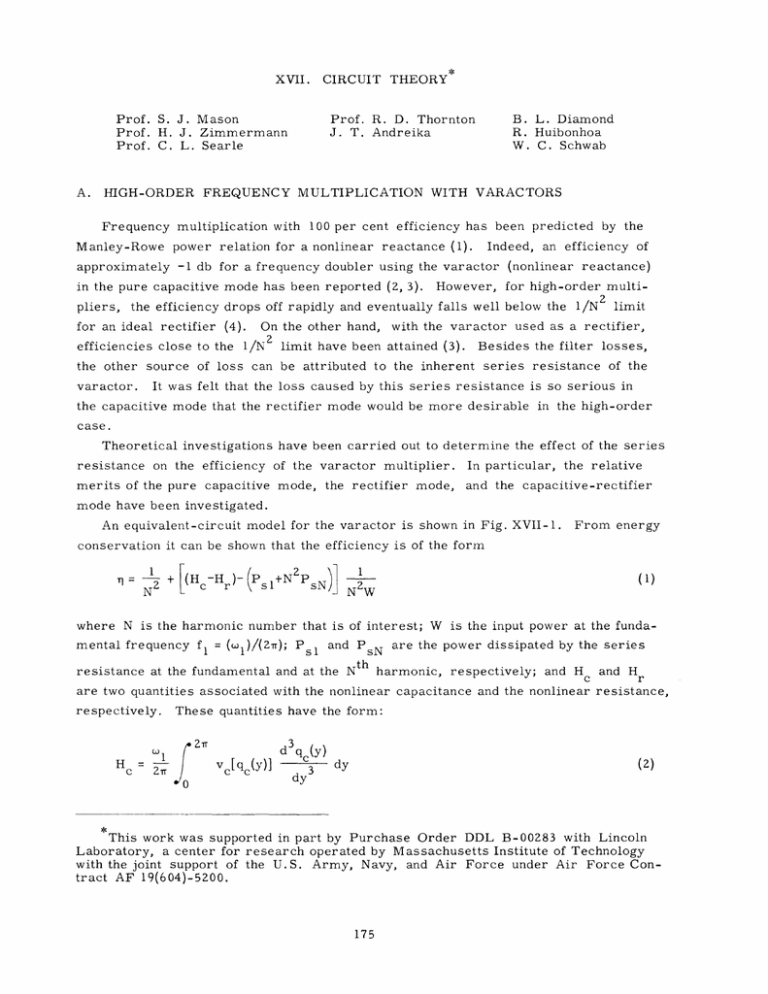
XVII. CIRCUIT THEORY Prof. S. J. Mason Prof. H. J. Zimmermann Prof. C. L. Searle A. HIGH-ORDER Prof. R. D. Thornton J. T. Andreika FREQUENCY MULTIPLICATION B. L. Diamond R. Huibonhoa W. C. Schwab WITH VARACTORS Frequency multiplication with 100 per cent efficiency has been predicted Indeed, an efficiency of reactance (1). Manley-Rowe power relation for a nonlinear by the approximately -1 db for a frequency doubler using the varactor (nonlinear reactance) in the pure capacitive mode has been reported (2, 3). pliers, However, for high-order multi- the efficiency drops off rapidly and eventually falls well below the 1/N for an ideal rectifier (4). On the other hand, efficiencies close to the 1/N 2 2 limit with the varactor used as a rectifier, limit have been attained (3). Besides the filter losses, the other source of loss can be attributed to the inherent series resistance of the It was felt that the loss caused by this series resistance is so serious in varactor. the capacitive mode that the rectifier mode would be more desirable in the high-order case. Theoretical investigations have been carried out to determine the effect of the series resistance on the efficiency of the varactor multiplier. In particular, the relative merits of the pure capacitive mode, the rectifier mode, and the capacitive-rectifier mode have been investigated. An equivalent-circuit model for the varactor is shown in Fig. XVII-1. From energy conservation it can be shown that the efficiency is of the form n = N 2 + (H -H I c r )- P N2 W +N2N sN/ (1) N2 where N is the harmonic number that is of interest; W is the input power at the fundamental frequency fl = (wl)/(Z1); P s l and PsN are the power dissipated by the series resistance at the fundamental and at the N th and H c and H r are two quantities associated with the nonlinear capacitance and the nonlinear resistance, respectively. c respectively; These quantities have the form: l H harmonic, 2 0 d dqc(Y) 3 vc[q(Y)] dy (2) dy This work was supported in part by Purchase Order DDL B-00283 with Lincoln Laboratory, a center for research operated by Massachusetts Institute of Technology with the joint support of the U.S. Army, Navy, and Air Force under Air Force Contract AF 19(604)-5200. 175 (XVII. CIRCUIT THEORY) r 1 dv (i) 2T di r dir(Y) L y dy (3) where y = wIt; and vc(qc ) and vr (ir) are the nonlinear characteristics for the capacitor and the resistor. For positive capacitance and positive resistance, it can be shown that both H and H are positive. c r With reference to Eq. 1, it is seen that in order for r > 1/N Z , the condition H - H > P + N2P c r sl sN (4) must be satisfied. These conclusions can be deduced from this condition. First, the presence of the term H can only render the inequality difficult to meet. Thus, the capacitive mode of operation is the more desirable. Second, the rectifier mode is made more effective by the presence of the nonlinear capacitance C(v) (H >0). Third, the N2 term on the righthand side of Eq. 4 reveals the rapid deterioration of the high-order multiplier in the R(v) Rs presence of the varactor series resistance. However, since the quantities in Eq. 4 are all functions of the actual circuit parameters, the series resistance, the input power, and the harmonic number, realizability of the condition of optimal operation can best be investigated by an analysis of the actual circuit. This investigation is now proceeding. R. Huibonhoa Fig. XVII-1. Equivalent-circuit model for a varactor. References 1. J. M. Manley and H. E. Rowe, Some general properties of non-linear elements. Part I. General energy relations, Proc. IRE 44, 903-913 (1956). 2. D. B. Leeson and S. Weinreb, Frequency multiplication with nonlinear capacitors - A circuit analysis, Proc. IRE 47, 2076 (1959). 3. Interim Progress Report on Contract No. NAsw-33, Research Laboratory of Electronics, M.I.T., Dec. 1, 1959; see Sections 2 and 3. 4. C. H. Page, Harmonic generation, Proc. IRE 46, 1738 (1958). 176





